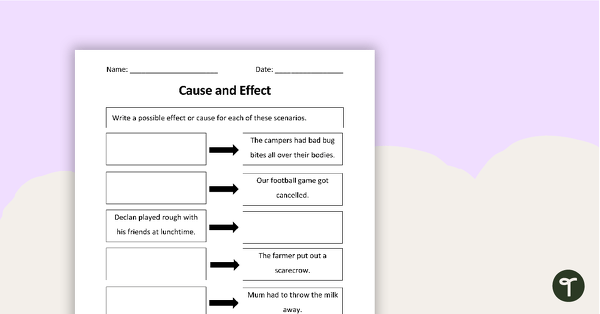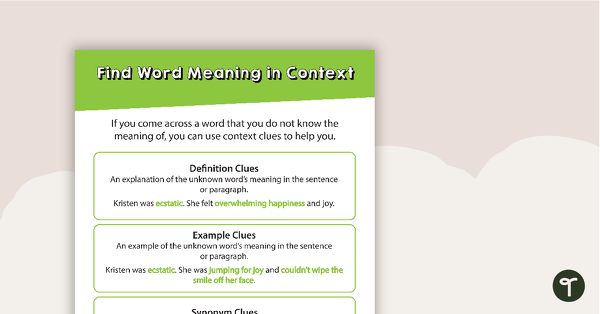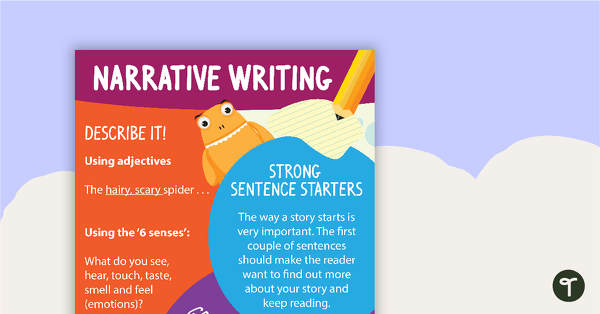Year 4
The English curriculum is built around the three interrelated strands of language, literature and literacy. Teaching and learning programs should balance and integrate all three strands. Together, the strands focus on developing students' knowledge, understanding and skills in listening, reading, viewing, speaking, writing and creating. Learning in English builds on concepts, skills and processes developed in earlier years, and teachers will revisit and strengthen these as needed.
In Years 3 and 4, students experience learning in familiar contexts and a range of contexts that relate to study in other areas of the curriculum. They interact with peers and teachers from other classes and schools in a range of face-to-face and online/virtual environments.
Students engage with a variety of texts for enjoyment. They listen to, read, view and interpret spoken, written and multimodal texts in which the primary purpose is aesthetic, as well as texts designed to inform and persuade. These encompass traditional oral texts including Aboriginal stories, picture books, various types of print and digital texts, simple chapter books, rhyming verse, poetry, non-fiction, film, multimodal texts, dramatic performances and texts used by students as models for constructing their own work.
The range of literary texts for Foundation to Year 10 comprises Australian literature, including the oral narrative traditions of Aboriginal and Torres Strait Islander Peoples, as well as the contemporary literature of these two cultural groups, and classic and contemporary world literature, including texts from and about Asia.
Literary texts that support and extend students in Years 3 and 4 as independent readers describe complex sequences of events that extend over several pages and involve unusual happenings within a framework of familiar experiences. Informative texts include content of increasing complexity and technicality about topics of interest and topics being studied in other areas of the curriculum. These texts use complex language features, including varied sentence structures, some unfamiliar vocabulary, a significant number of high-frequency sight words and words that need to be decoded phonically, and a variety of punctuation conventions, as well as illustrations and diagrams that support and extend the printed text.
Students create a range of imaginative, informative and persuasive types of texts including narratives, procedures, performances, reports, reviews, poetry and expositions.
(source: www.australiancurriculum.edu.au)
Achievement Standard
Receptive modes (listening, reading and viewing)
By the end of Year 4, students understand that texts have different text structures depending on purpose and context. They explain how language features, images and vocabulary are used to engage the interest of audiences. They describe literal and implied meaning connecting ideas in different textsÂ
They fluently read texts that include varied sentence structures, unfamiliar vocabulary including multisyllabic words. They express preferences for particular types of texts, and respond to others' viewpoints. They listen for and share key points in discussions.
Productive modes (speaking, writing and creating)
Students use language features to create coherence and add detail to their texts. They understand how to express an opinion based on information in a text. They create texts that show understanding of how images and detail can be used to extend key ideas.
Students create structured texts to explain ideas for different audiences. They make presentations and contribute actively to class and group discussions, varying language according to context. They demonstrate understanding of grammar, select vocabulary from a range of resources and use accurate spelling and punctuation, re-reading and editing their work to improve meaning.
(source: www.australiancurriculum.edu.au)
- Plus Plan

Procedural Writing Checklists
Use these procedural writing checklists when teaching your students how to editing their procedure texts.
- Plus Plan

Write a Shape Poem Worksheet
Set your students up for success when writing a shape poem with this set of scaffolded, easy-to-follow worksheets.
- Plus Plan

Types of Poetry Posters with Annotations
Use this set of 9 annotated posters when introducing structured forms of poetry to your students.
- Free Plan

Partner Sentence Challenge Worksheet
A teaching resource to help students consolidate the students’ knowledge of grammar and brainstorm vocabulary for writing.
- Free Plan

Writing a Speech Poster
A poster highlighting the main parts to a speech.
- Plus Plan

Author's Purpose - Sorting Worksheet
A teaching resource to help teach your students the different reasons authors may write.
- Plus Plan

Cause and Effect - Scenario Worksheet
A worksheet and answer sheet to use when teaching students the cause and effect comprehension strategy.
- Plus Plan

120 Comprehension Strategy Question Cards
A set of 120 open-ended question cards to help students apply comprehension strategies when reading.
- Plus Plan

Comprehension Task Cards - Compare And Contrast
A set of comprehension task cards to help students compare and contrast when reading.
- Plus Plan

Comprehension Task Cards - Making Predictions
A set of comprehension task cards to help students make predictions when reading.
- Plus Plan

Comprehension Task Cards - Finding Word Meaning In Context
A set of comprehension task cards to help students find word meaning in context when reading.
- Plus Plan

Reading Detectives Name Tags
8 colourful reading detective name tags to assign students during guided reading sessions.
- Plus Plan

Reading Comprehension Strategies PowerPoint - Questioning
A 15 slide editable PowerPoint template explaining the reading comprehension strategy of questioning.
- Plus Plan

Reading Comprehension Strategies PowerPoint - Activating Prior Knowledge
A 13 slide editable PowerPoint template explaining the reading comprehension strategy of activating prior knowledge.
- Plus Plan

Cars Fact File and Report Writing Scaffold
Support your students in writing an information report about cars with this fact file and writing scaffold.
- Plus Plan

Doctors Fact File and Report Writing Scaffold
Support your students in writing an information report about doctors with this fact file and writing scaffold.
- Plus Plan

Eagles Fact File and Report Writing Scaffold
Support your students in writing an information report about eagles with this fact file and writing scaffold.
- Plus Plan

Elephants Fact File and Report Writing Scaffold
Support your students in writing an information report about elephants with this fact file and writing scaffold.
- Plus Plan

Comprehension Strategies - Interactive PowerPoint
An engaging 48 slide interactive PowerPoint to use in the classroom when developing comprehension strategies.
- Plus Plan

Distinguish Between Real and Make-Believe Poster
A poster highlighting how to distinguish between real and make-believe when reading a piece of text.
- Plus Plan

Find Word Meaning in Context Poster
A poster highlighting how to find word meaning in context when reading a piece of text.
- Plus Plan

Homophones Bingo
Make learning about homophones and their definitions an engaging whole-class activity with this homophones bingo game.
- Plus Plan

Understand Sequence Poster
A poster highlighting how to sequence when reading a piece of text.
- Plus Plan

Recognise Cause and Effect Poster
A poster highlighting how to recognise cause and effect when reading a piece of text.
- Plus Plan

Identify Author's Purpose Poster
A poster highlighting how to identify the author's purpose when reading a piece of text.
- Plus Plan

Information Report Writing Template
Use this information report template to help your students correctly structure their informative writing.
- Plus Plan

Paragraph Study Grammar Interactive PowerPoint
Interactive PowerPoint presentation allowing teachers and students to learn and revise grammar by highlighting paragraphs.
- Plus Plan

Understanding Sequence - Jack and the Beanstalk
A worksheet to use when teaching students how to understand sequence when reading.
- Plus Plan

Narrative Paragraphs Sequencing Activity
6 jumbled narrative paragraphs for students to sequence in the correct order.
- Plus Plan

Grammar Word Search with Solution
A word search to help your students learn a variety of grammatical terms.
- Plus Plan

Narrative Writing Poster
A poster to encourage your students to think about narrative writing.
- Plus Plan

Introduction to Narrative Features PowerPoint - Year 3 and Year 4
A 23 slide editable PowerPoint template to use when teaching your students about the features of narrative texts.